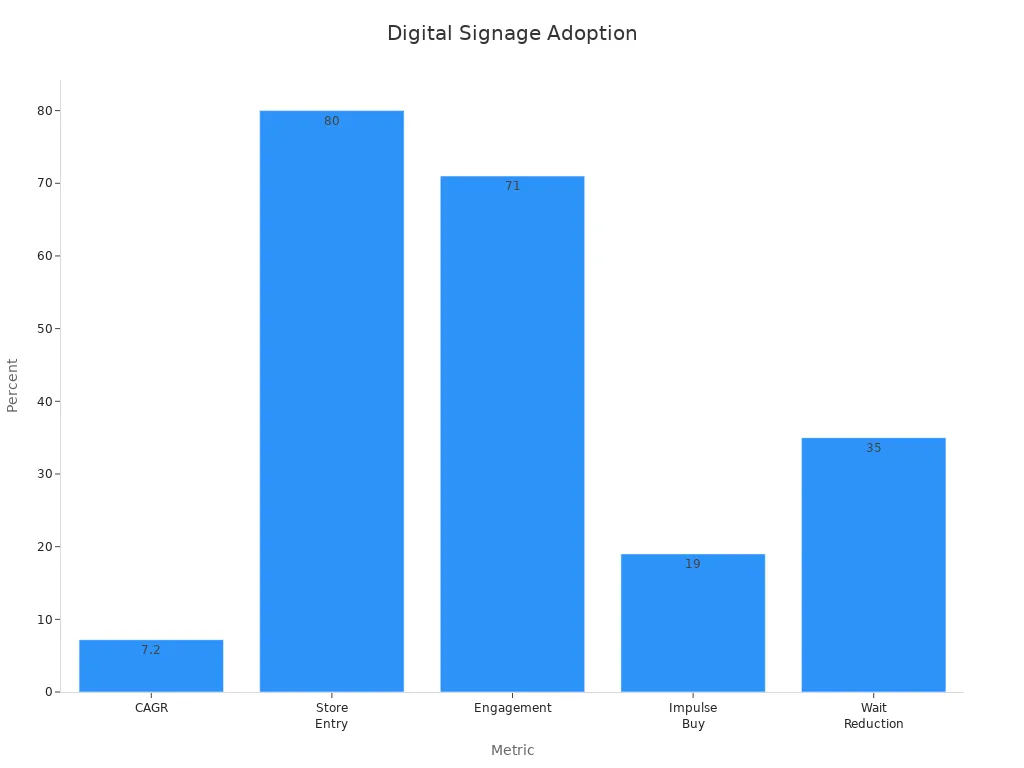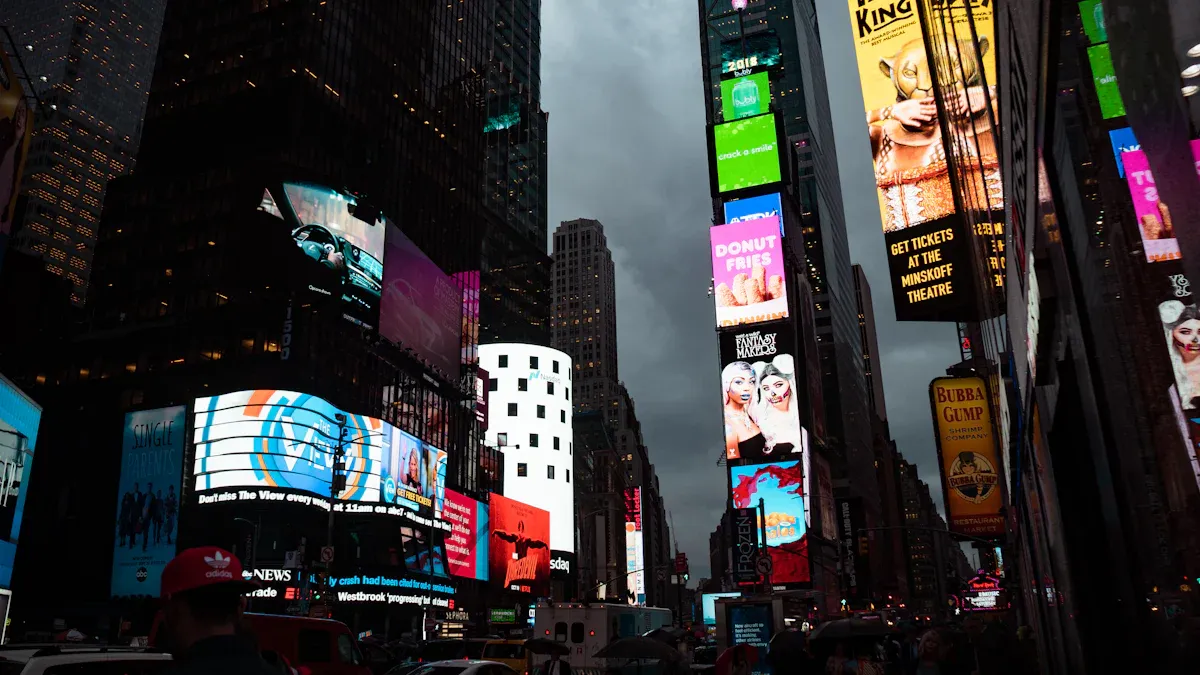Digital Signage Display Suppliers: Comparing Service, Quality, and Support

Choosing the best digital signage suppliers is important.
Good service, quality, and support help a lot.
They can make work 25% faster.
They can also make customers 46% happier.
Suppliers with great signs help people talk better.
They also make your brand look better.
A helpful guide shows how to pick the right supplier.
This helps businesses get the most value for a long time.
Key Takeaways
Pick suppliers who answer quickly and help you when needed.
Choose screens that are bright, clear, and last a long time.
Think about smart screens and online systems for easy use.
Look at both local and global companies for your needs and budget.
Make a good budget, read real reviews, and pick suppliers who can grow with you.
Key Criteria
Service
Service is very important when picking a supplier.
Businesses want suppliers who answer fast and talk clearly.
Good customer support helps fix problems quickly.
Suppliers who give simple setup steps help teams start fast.
Many companies want full support, like training and guides.
Good service makes sure signs work well from day one.
It also helps signs keep meeting business needs.
Quality
Quality affects how well signs work and how long they last.
Suppliers must check their products carefully.
They do this by testing design, watching production, and checking after making.
For example, they use machines to inspect and test for long use.
They check screens for clear pictures, brightness, and colors.
They also test if screens can handle heat, cold, dust, and shaking.
The table below lists some main quality checks:
Quality Control Aspect | Description |
|---|---|
Design Validation | Making and checking samples for safety and standards. |
Production Monitoring | Using machines and checks during making. |
Post-Production Testing | Final tests to make sure signs work well. |
Environmental Testing | Checking if signs last in heat, cold, dust, and shaking. |
Performance Testing | Testing how clear, bright, and stable the screens are. |
Good quality means signs break less and always show clear messages.
Support
Support means helping customers and fixing tech problems.
Suppliers should help before, during, and after setup.
Quick help solves problems fast.
Tech support helps with updates and fixing hardware.
Many businesses want guides and online help.
Good support keeps signs working, even as tech changes.
This makes businesses feel safe about their choice.
Digital Signage Hardware

Screen Options
Businesses have many choices for digital signs.
The main types are regular screens, smart screens, and video walls.
Regular screens need a player to show pictures or videos.
Smart screens have computers inside, so no extra device is needed.
This makes setup simple and saves money.
Many smart screens can play 4K videos and look smooth.
They are a good pick for most uses.
Screen size and sharpness are important.
Small screens, like 42 to 55 inches, fit stores or offices.
Video walls use many screens together for a big display.
These are great for airports, malls, or stadiums.
Video walls cost more and are harder to set up.
But they make displays stand out by up to 40%.
See the table below for a screen comparison:
Feature / Vendor | SONY Consumer Models | NEC Commercial Displays | PPDS Commercial Displays |
|---|---|---|---|
Price Range (65-inch) | $700-$3,500 | $1,600-$2,300+ | Varies |
Brightness & Contrast | Moderate to High | High, 24/7 use | High, ruggedized |
Operational Hours | 18/7 | 18/7 to 24/7 | Continuous |
Warranty & Durability | Consumer warranty | Extended, reliable | Commercial warranty |
Hardware Integration | Needs players | Network management | Android OS embedded |
Use Case Suitability | Retail, hotels | Corporate, airports | Retail, education |
💡 Tip: Pick screens that fit your space and content.
Bright screens work best in sunny places.
Players and Accessories
Digital signage players show what is on the screens.
Some screens need a player, but smart screens do not.
External players help with special videos or software.
Accessories like mounts, stands, and cables help set up screens safely.
Other hardware includes network switches and power supplies.
These parts help the system work well every day.
Pick hardware that is easy to use and can grow with your needs.
This helps your signs last a long time.
Digital Signage Providers
Local vs. International
Businesses can pick local or international sign providers.
Each choice has good and bad points.
Local providers are close by, so delivery is fast.
They know what local people need.
They give good help when things break.
Prices are clear, with no hidden fees.
But local providers may cost more at first.
They might not have the newest technology.
International providers have more products to choose from.
They offer new features and cool tech.
You can get discounts if you buy a lot.
These providers help your business stand out.
But shipping takes longer from far away.
Warranties can be harder to use.
Talking to them can be tough because of time zones.
It may take longer to get help.
Aspect | Local Providers Good Points | Local Providers Bad Points | International Providers Good Points | International Providers Bad Points |
|---|---|---|---|---|
Supply Chain | Fast delivery | Not much stock | Save money on big orders | Slow shipping, risk of damage |
Pricing | Clear prices, no hidden fees | Costs more at first | Discounts for buying a lot | Extra fees: shipping, taxes |
Product Quality | Knows local needs, good support | Older tech, not as advanced | New tech, many choices | Some products may not be as good |
Customization | Fits local needs | Not many options | Special features, lots of choices | Hard to talk about changes |
Customer Support | Quick and reliable | — | Help from big brands | Slow help, time zone problems |
Warranty & Service | Easy to fix problems | — | Brand warranty | Hard to return or fix things |
Import Regulations | — | — | — | Hard rules for shipping and laws |
Long-Term Partnership | Easy to build trust | — | — | — |
Note: Pick what fits your goals, money, and tech needs.
Cloud-Based Solutions
Cloud-based signs let you control screens from anywhere.
You just need the internet to change what shows.
No need to buy big servers for your office.
Cloud systems are easy to update and fix.
They help you grow fast if you need more screens.
More businesses use cloud signs every year.
In 2024, the market was $27.96 billion.
By 2033, it may reach $52.27 billion.
The market grows about 7.2% each year.
Stores, hospitals, hotels, and buses use cloud signs.
They like saving money and being flexible.

Cloud signs cost less at the start with subscriptions.
You can manage screens from far away.
This makes signs easier for all businesses.
More companies pick cloud signs to grow and change fast.
Digital Signage Solutions
Integrated Systems
Integrated systems put hardware and software together.
This makes digital signs easy to use and set up.
You do not need lots of different parts.
It is less confusing for workers and owners.
Everything works well together in one system.
This helps things run smoothly and saves time.
Some big companies use these systems.
McDonald's uses touch screens for ordering food.
This helps people order faster and with fewer mistakes.
Adidas uses digital signs in pop-up shops.
They have mirrors you can try on clothes with.
They also show deals and connect to social media.
Case Study | Company | What They Did | How It Helped |
|---|---|---|---|
1 | McDonald's | Touch screens for orders, many ways to pay | Faster orders, better service, more sales, happy customers |
2 | Adidas | Signs in stores, try-on mirrors, social media, live deals | More people visit, more fun, more talk online, easy to change ads |
3 | Sephora | Screens with info, AR mirrors, online and store work together | More sales, loyal shoppers, easy shopping |
4 | Tesla | Touch screens, VR test drives, live info on screens | Learn more, more sales, strong brand, good data |
These show how systems help customers and boost sales.
Software Platforms
Software helps control what shows on digital signs.
It lets you make, plan, and change messages easily.
A simple design helps everyone learn fast.
Teams can focus on making good messages.
Most software works almost all the time.
Signs stay on 99.9% of the time.
People interact with signs 3 to 5 times per visit.
Some platforms, like DigitalSignage.com and ScreenCloud,
let you watch signs live and use smart features.
You can change messages for different people.
You can also pick the best time to show ads.
This makes sure the right people see your message.
Cloud and local options both work for many needs.
💡 Tip: Pick software that is easy to use and lets you plan messages well.
Comparison

Strengths and Weaknesses
Businesses look at what each digital sign supplier does well and not so well.
Every supplier has different features, help, and ways to connect with other tools.
The table below shows what each top supplier is good at and where they are not as strong:
Supplier | Strengths | Weaknesses |
|---|---|---|
Scala | Strong tools for content and tracking | Hard to learn for new users |
BrightSign | Great video quality, strong management | Needs special hardware |
MagicINFO | Works well with Samsung, flexible content | Not good with other brands |
SignageTube | Easy cloud use, simple design, good support | No hardware needed, made for easy use |
Scala helps you see how your signs are doing and talk better with customers.
But it can be hard for beginners, so they may need extra help.
BrightSign gives clear videos and is easy to manage, but you must buy their hardware, which can cost more.
MagicINFO is best for Samsung screens and lets you show many types of content, but it does not work with most other brands.
SignageTube is simple to use online and has strong support, so it is good for teams who want to start fast and save money.
When comparing, companies should look at important numbers.
These include:
How many people see the signs.
How often people touch or use the signs.
How many people buy something after seeing the sign.
Other things like visits, how long people stay, and how much they spend.
Ways to measure, like checking data, testing, or watching people.
Money results and other goals, like ROI and ROO.
These numbers help companies pick the best supplier for their needs and budget.
Note: No one supplier is perfect for everyone.
Pick the one that matches your needs, money, and plans.
Customer Reviews
Customer reviews are very important when picking a supplier.
Good reviews show what real people think about using digital signs.
Experts use different ways to make sure reviews are honest:
They test the top platforms to see if they are easy to use and fit business needs.
They work with experts to pick tools based on user help and how well they schedule content.
They use AI to check real reviews and find common ideas.
Suppliers and review sites also do these things:
Make sure reviewers are real people.
Give small rewards, like gift cards, for honest reviews.
Share what job the reviewer has and what kind of business they work in.
Use AI to spot real opinions and patterns in reviews.
These steps help people trust what they read.
Good reviews often say suppliers give fast help and easy setup.
Some reviews say the system saves money or helps sell more.
Bad reviews may talk about hidden costs or slow help.
Tip: Always look for real reviews and see if people say the same things.
If many people talk about support, cost, or how easy it is, you can learn what the supplier is really like.
Looking at both good and bad points, plus real customer reviews, helps businesses choose wisely.
This way, they get better results and talk to customers more easily.
Choosing a Supplier
Picking a digital sign supplier takes planning.
You need to think about price, help, and if it can grow.
The right pick helps you use money well and keeps things running.
Budget
Start by checking all the costs.
Look at screens, software, setup, and fixing.
Buying many screens can make each one cheaper.
Using cloud software can save money too.
Setting up and fixing signs costs extra.
Screens that use less power save money over time.
Big projects may have legal costs to follow rules.
Hardware: Compare home and business screens.
Business screens last longer but cost more.Software: Check if free software has what you need.
Paid software may have better tools.Installation: Get prices from different suppliers.
Bundled deals can save money.Maintenance: Plan for updates and repairs.
Cloud signs often cost less to fix.Volume Discounts: Ask for lower prices if you buy a lot.
ROI: Think about how signs can help you sell more.
Project Size | Typical Cost Range |
|---|---|
Small | $30,000–$50,000 |
Mid-size | $100,000–$200,000 |
Large-scale | Over $500,000 |
Tip: Always check contracts for hidden costs.
Make sure the deal fits your type of business.
Support Needs
Good help is needed to keep signs working.
Fast answers fix problems before they get big.
Check how fast suppliers reply and if they help all day.
Good tech help means less waiting and better signs.
Ask other customers if they like the support.
See if you get training and guides.
Pick suppliers known for quick, helpful service.
Make sure help covers both screens and software.
Check if help includes scheduling and updates.
Note: Good help is as important as price.
Slow support can stop your business and cost money.
Scalability
Scalability means your system can grow with you.
Your signs should work in more places as you grow.
Pick suppliers who make upgrades easy.
Choose systems that let you update signs right away.
Make sure it works with your other tools.
Use visitor numbers to see if signs reach people.
Track sales and leads to see if signs help you grow.
Ask if the supplier has done big and small jobs.
Scalability Checklist | Yes/No |
|---|---|
Can add screens easily | |
Supports remote management | |
Handles high visitor counts | |
Offers flexible scheduling | |
Integrates with other systems |
Tip: Pick a supplier who can grow with you.
Practical Checklist for Evaluating Suppliers
Check all costs: screens, software, setup, fixing.
Look for energy-saving screens.
Test how fast and good the support is.
Make sure tech help covers everything.
See if scheduling is easy to use.
Look for ways to change signs for your needs.
Make sure you can add more signs later.
Ask for stories from other customers.
Compare offers and try to get a better deal.
Steps for Requesting Proposals and Comparing Offers
Write down what you need from your signs.
Ask many suppliers for their best offers.
Get a list of all costs and services.
Check what kind of help you get.
Compare how easy it is to schedule and change signs.
Make sure you can upgrade later.
Read reviews and talk to other customers.
Try to get a better price or deal.
Pick the supplier that fits your needs and plans.
Remember: The best supplier is not just the cheapest.
Good help and room to grow matter too.
Careful planning helps you get the best results.
Picking the best supplier means matching what they do well to your business goals.
Think about how your company might grow in the future.
Compare service, quality, and support with easy-to-understand rules.
The table below shows top suppliers and what makes them special:
Supplier | What They Do Well | Extra Facts |
|---|---|---|
Samsung | Great quality, trusted | 30% of TVs sold worldwide |
LG | 4K screens, good help | Biggest choice of 4K screens |
Sony | Bright, clear screens | Used in many places |
Philips | New ideas, easy to use | Focuses on brand experience |
Companies feel sure when they read real reviews and see clear product info before picking a supplier.
FAQ
What is the difference between commercial and consumer screens?
Commercial screens are made for busy places.
They last longer and are brighter than home screens.
They can be used for many hours each day.
Consumer screens are cheaper but may break faster.
Home screens may not work well for businesses.
How often should businesses update their content?
Most experts say to change content every week or month.
New content keeps people interested in the screens.
It helps show new sales or news to customers.
Updating often stops screens from looking old or boring.
Can digital signage systems work without internet access?
Some signs can work without the internet.
You can put videos or pictures on a USB drive.
You can also use a local network to load content.
Cloud signs need the internet to update from far away.
What should companies look for in supplier support?
Companies should want fast answers and clear help.
Good support means help any time, day or night.
Suppliers should give training and fix problems quickly.
They should also update the software often.
Good help keeps signs working well.
How do businesses measure the success of their signage?
Businesses count how many people see the signs.
They check if people touch or use the screens.
They look at sales numbers after using signs.
Some use special tools to track these numbers.
This helps them know if signs are worth the money.
See Also
Custom Digital Signage Strategies For Retail Healthcare And Business
Comparing Digital Signage And TVs: Choosing The Right Display
How To Implement Digital Signage For Optimal Return On Investment
Overview Of Digital Signage Display Solutions Available In Singapore
Integrating LED Displays With Digital Signage Technology Effectively

